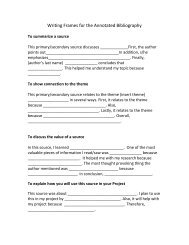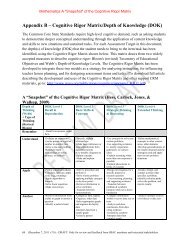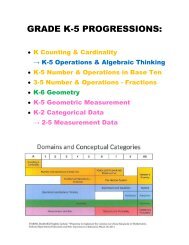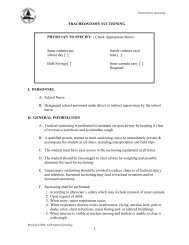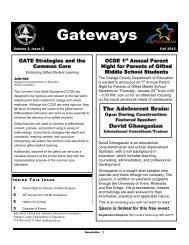The Promise and the Peril for Students with Disabilities - CalSTAT
The Promise and the Peril for Students with Disabilities - CalSTAT
The Promise and the Peril for Students with Disabilities - CalSTAT
You also want an ePaper? Increase the reach of your titles
YUMPU automatically turns print PDFs into web optimized ePapers that Google loves.
Executive Function<br />
from page 9<br />
be<strong>for</strong>e acting. This skill is necessary to<br />
filter out distractions, delay gratification,<br />
<strong>and</strong> break habitual behaviors. It<br />
is crucial <strong>for</strong> regulating emotions <strong>and</strong><br />
making choices about appropriate ways<br />
to express those emotions. We all need<br />
this skill to <strong>for</strong>ego doing what we want<br />
to do in place of doing what we are<br />
supposed to do—essentially to be able<br />
to discern <strong>the</strong> right choices to make<br />
<strong>and</strong> <strong>the</strong> most important things to attend<br />
to in any given moment. A child,<br />
<strong>for</strong> example, uses <strong>the</strong>se skills when<br />
continuing to build a block tower<br />
despite children running through <strong>the</strong><br />
area; when waiting to eat lunch until<br />
everyone is served; when playing such<br />
games as “Red Light/Green Light” <strong>and</strong><br />
“Simon Says”; <strong>and</strong> when, after being<br />
hit by ano<strong>the</strong>r child, calling <strong>for</strong> help<br />
instead of hitting back, despite being<br />
very angry. Adults use <strong>the</strong>se skills<br />
when <strong>the</strong>y go to work ra<strong>the</strong>r than<br />
staying in bed after a late night, when<br />
<strong>the</strong>y don’t yell at <strong>the</strong>ir boss <strong>for</strong> a harsh<br />
per<strong>for</strong>mance evaluation, <strong>and</strong> when <strong>the</strong>y<br />
get up to com<strong>for</strong>t a crying child when<br />
<strong>the</strong>y’d ra<strong>the</strong>r sleep.<br />
Cognitive or mental flexibility<br />
is <strong>the</strong> capacity to shift gears <strong>and</strong> scan<br />
options <strong>for</strong> how to respond appropriately—both<br />
intellectually <strong>and</strong> emotionally.<br />
It is <strong>the</strong> ability to adjust to<br />
changes, revise plans, <strong>and</strong> consider<br />
something from a different perspective.<br />
This flexibility helps a person sort out<br />
competing dem<strong>and</strong>s, priorities, <strong>and</strong><br />
expectations.<br />
Cognitive flexibility supports a<br />
child’s ability to effectively manage<br />
such things as transitions, to try multiple<br />
options <strong>for</strong> conflict resolution, <strong>and</strong><br />
to underst<strong>and</strong> rules <strong>and</strong> expectations<br />
that might be situational (e.g., “In<br />
<strong>the</strong> morning we can play <strong>with</strong> water,<br />
but in <strong>the</strong> afternoon we play <strong>with</strong> <strong>the</strong><br />
s<strong>and</strong>”; or, when a child is older, “I<br />
can swim in <strong>the</strong> pool, but only when<br />
<strong>the</strong>re’s a lifeguard present.”<br />
<strong>The</strong> three domains work in an interrelated<br />
fashion to support optimal<br />
executive functioning. For example, it<br />
takes working memory to recall that<br />
<strong>the</strong> teacher told you to put your coat<br />
<strong>and</strong> backpack in your cubby be<strong>for</strong>e<br />
going to <strong>the</strong> table, inhibitory control<br />
to resist <strong>the</strong> urge to throw <strong>the</strong> things<br />
on <strong>the</strong> floor <strong>and</strong> run to <strong>the</strong> table <strong>with</strong><br />
excitement to start playing, <strong>and</strong> cognitive<br />
flexibility to follow <strong>the</strong> teacher’s<br />
expectations—when at home you do<br />
get to drop things on <strong>the</strong> floor <strong>and</strong><br />
your mom puts <strong>the</strong>m away <strong>for</strong> you.<br />
When fully integrated, skills that make<br />
up <strong>the</strong> executive functions support a<br />
person’s ability to engage in purposeful,<br />
goal-directed, problem-solving behavior<br />
by overriding impulsive thoughts<br />
<strong>and</strong> responses in order to think through<br />
possible outcomes <strong>and</strong> realize goals.<br />
According to research from <strong>the</strong><br />
Center at Harvard, children’s EF skills<br />
facilitate early cognitive achievement<br />
in school in <strong>the</strong> areas of reading, writing,<br />
<strong>and</strong> math. Scientists argue that<br />
EF skills “support <strong>the</strong> process (i.e., <strong>the</strong><br />
how) of learning—focusing, remembering,<br />
planning—that enables children<br />
to effectively <strong>and</strong> efficiently master <strong>the</strong><br />
content (i.e., <strong>the</strong> what) of learning—<br />
reading, writing, computation.”<br />
What Happens in <strong>the</strong> Brain?<br />
<strong>The</strong> capacity <strong>for</strong> cognitive processing<br />
is dependent upon <strong>the</strong> healthy development<br />
of several systems in <strong>the</strong> prefrontal<br />
areas of <strong>the</strong> brain, which begin to<br />
<strong>for</strong>m during infancy <strong>and</strong> continue to<br />
grow <strong>and</strong> refine throughout adolescence<br />
<strong>and</strong> into early adulthood. In <strong>the</strong>ir book<br />
<strong>The</strong> Whole-Brain Child, Daniel Siegel<br />
<strong>and</strong> Tina Payne Bryson (2011) liken<br />
<strong>the</strong> brain to a house that contains both<br />
a downstairs <strong>and</strong> upstairs. <strong>The</strong> “downstairs”<br />
brain, which includes <strong>the</strong> limbic<br />
system <strong>and</strong> brain stem, develops first<br />
<strong>and</strong> is responsible <strong>for</strong> primary bodily<br />
functions such as breathing, heartbeat,<br />
<strong>and</strong> reflexive reactions <strong>and</strong> impulses.<br />
<strong>The</strong> fight, flight, or freeze response is<br />
seated in this part of <strong>the</strong> brain, as is<br />
emotional reactivity.<br />
Siegel <strong>and</strong> Bryson<br />
Web sites are at<br />
http://drdansiegel.com<br />
<strong>and</strong> http://tinabryson.com.<br />
Much of <strong>the</strong> normal behavior seen<br />
in very young children comes directly<br />
from this downstairs brain: r<strong>and</strong>om<br />
movement from activity to activity,<br />
<strong>the</strong> inability to follow serial directions,<br />
distractibility, impulsivity, emotional<br />
outbursts, <strong>and</strong> underdeveloped empathy.<br />
<strong>The</strong> “upstairs” brain, or <strong>the</strong><br />
cerebral cortex <strong>and</strong> its various parts, is<br />
where <strong>the</strong> brain’s executive functioning<br />
activity occurs: <strong>the</strong> ability to focus,<br />
think, plan, organize, control impulses,<br />
<strong>and</strong> regulate emotions. While this upstairs<br />
brain isn’t fully developed until<br />
a person’s mid-twenties, evidence of<br />
executive functioning appears in early<br />
childhood.<br />
As children develop, <strong>the</strong>y begin to<br />
attend to tasks <strong>for</strong> longer periods of<br />
time; can follow multiple-step directions;<br />
<strong>and</strong> show a burgeoning capacity<br />
to stop, think, <strong>and</strong> act be<strong>for</strong>e grabbing<br />
a toy, running into <strong>the</strong> street, or hitting<br />
<strong>the</strong>ir friends. What’s more, <strong>the</strong>y begin<br />
to identify, underst<strong>and</strong>, express, <strong>and</strong><br />
manage <strong>the</strong>ir emotions in appropriate<br />
ways—evidence that <strong>the</strong> upstairs<br />
brain is becoming integrated <strong>with</strong> <strong>the</strong><br />
downstairs brain. Siegel <strong>and</strong> Bryson<br />
call this process “vertical integration,”<br />
as <strong>the</strong> “staircase in <strong>the</strong> mind” connects<br />
<strong>the</strong> downstairs brain, which developed<br />
early, <strong>with</strong> <strong>the</strong> upstairs brain, which is<br />
still under construction. This vertical<br />
integration allows children to gradu-<br />
10 u <strong>The</strong> Common Core State St<strong>and</strong>ards Summer 2012 u <strong>The</strong> Special EDge




